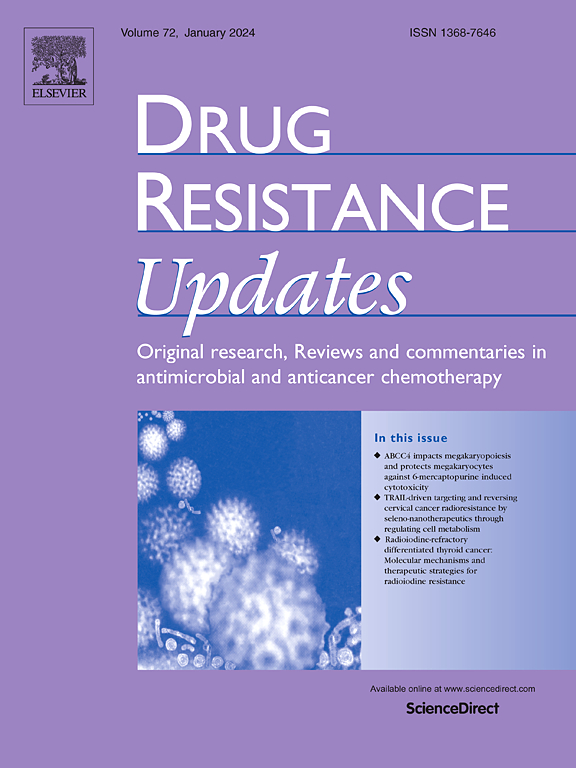蛋白酶体通过抑制线粒体蛋白输入和促进ros - bnip3介导的线粒体自噬来抑制抗癌药物诱导的细胞毒性
IF 21.7
1区 医学
Q1 PHARMACOLOGY & PHARMACY
引用次数: 0
摘要
多药耐药(MDR)与蛋白酶体活性增加有关,蛋白酶体活性增加有助于清除受损蛋白质,线粒体活性降低有助于静止。然而,蛋白质损伤、线粒体功能障碍和蛋白酶体活性之间的机制联系仍然难以捉摸。在这里,我们证明了化学药物与新合成的线粒体蛋白结合,这些线粒体蛋白在出现在溶酶体和/或细胞核之前,大部分未展开并共同导入线粒体。这触发了线粒体仅体介导的连锁反应,包括线粒体完整性应激反应(ISR)和线粒体未折叠蛋白反应(UPRmt),随后增加溶酶体生物发生和PINK1-Parkin独立但ros - bnip3介导的线粒体自噬。我们进一步观察到,在正常和药物治疗条件下,蛋白酶体是线粒体仅体反应的主要控制者,通过监测蛋白质稳态,抑制线粒体蛋白进口和促进线粒体自噬。化学药物与蛋白酶体抑制剂硼替佐米(bortezomib, BTZ)联合使用,引发线粒体过度输入受损蛋白,线粒体容量过大,导致线粒体膜损伤,线粒体ROS大量产生,溶酶体膜渗透,线粒体自噬受损,蛋白稳态应激诱导细胞死亡。本文章由计算机程序翻译,如有差异,请以英文原文为准。
Proteasomes suppress anticancer drug-induced cytotoxicity by inhibiting mitochondrial protein import and promoting ROS-BNIP3-mediated mitophagy
Multidrug resistance (MDR) is associated with increased proteasome activity, which facilitates the clearance of damaged proteins and reduced mitochondrial activity, which contributes to quiescence. However, the mechanistic link between protein damage, mitochondrial dysfunction, and proteasome activity remains elusive. Here, we demonstrate that chemical drugs bind to newly synthesized mitochondrial proteins, which are largely unfolded and are coimported into the mitochondrion before appearing in the lysosome and/or nucleus. This triggers a mitochondrion-lysosome–mediated chain reaction, including the integrity stress response (ISR) and the mitochondrial unfolded protein response (UPRmt), followed by increased lysosome biogenesis and PINK1–Parkin independent but ROS–BNIP3–mediated mitophagy. We further observed that proteasomes are the main controller of the mitochondrion-lysosome reaction by monitoring proteostasis, suppressing mitochondrial protein import and promoting mitophagy under both normal and drug-treated conditions. The combination of chemical drugs and the proteasome inhibitor bortezomib (BTZ) triggered excessive mitochondrial import of damaged proteins, overwhelming mitochondrial capacity, causing mitochondrial membrane damage, profound mitochondrial ROS production, lysosome membrane permeabilization, impaired mitophagy, and proteostasis stress-induced cell death.
求助全文
通过发布文献求助,成功后即可免费获取论文全文。
去求助
来源期刊

Drug Resistance Updates
医学-药学
CiteScore
26.20
自引率
11.90%
发文量
32
审稿时长
29 days
期刊介绍:
Drug Resistance Updates serves as a platform for publishing original research, commentary, and expert reviews on significant advancements in drug resistance related to infectious diseases and cancer. It encompasses diverse disciplines such as molecular biology, biochemistry, cell biology, pharmacology, microbiology, preclinical therapeutics, oncology, and clinical medicine. The journal addresses both basic research and clinical aspects of drug resistance, providing insights into novel drugs and strategies to overcome resistance. Original research articles are welcomed, and review articles are authored by leaders in the field by invitation.
Articles are written by leaders in the field, in response to an invitation from the Editors, and are peer-reviewed prior to publication. Articles are clear, readable, and up-to-date, suitable for a multidisciplinary readership and include schematic diagrams and other illustrations conveying the major points of the article. The goal is to highlight recent areas of growth and put them in perspective.
*Expert reviews in clinical and basic drug resistance research in oncology and infectious disease
*Describes emerging technologies and therapies, particularly those that overcome drug resistance
*Emphasises common themes in microbial and cancer research
 求助内容:
求助内容: 应助结果提醒方式:
应助结果提醒方式:


